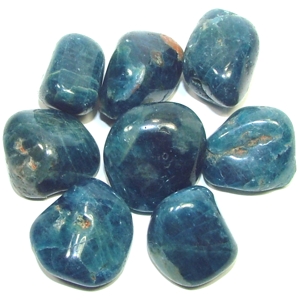| Crystal system | Hexagonal |
| Transparency | Transparent to semi-transparent |
| Luster | Vitreous |
| Fracture | Uneven |
| Cleavage | Imperfect |
| Specific Gravity | 3.18 ± .02 |
| Hardness | 5 |
| Optical Character | Uniaxial - ; Double Refractive |
| Refractive index | 1.642-1.646 |
| Birefringence | 0.002 - 0.006 |
| Dispersion | 0.013 |
| Fluorescence | Yellow Stones: lilac pink; blue stones: blue to sky blue; green stones: greenish yellow; violet stones: greenish yellow and pale mauve |
| Pleochroism | Blue stone: Strong yellow & blue; Other colors: Very weak |
| Chemical Formula | Ca5(PO4)3(F,Cl,OH) |
| Comments | Attacked readily by sulphuric and hydrochloric acids |
Since apatite occurs fairly frequently in cuttable quality, it has long been of interest to amateur lapidaries. It is too soft to be of much value as a gemstone, but it is often very attractive and is usually to be found in the collections of those who collect examples of all cuttable minerals. Its name is derived from the Greek word meaning "deceit", because some of the crystals resemble those of other minerals.
Apatite may be light yellow or green or various combinations thereof, light violet, amethyst colored, blue, pink, brown or colorless. It ranges from transparent to semi-translucent, but for years only the transparent stones were used for jewelry purposes, and these seldom found their way into the trade. Since a find was made of cat's-eye material in India, cat's-eye apatite has been sold widely in the jewelry industry.
Gem-quality material is usually found either in gem gravels or in phosphate rich pegmatite dikes. It is also found in metamorphic rocks. Mogok, Burma, produces some attractive blue and bluish-green apatite. Bluish-green material is also found in the alluvial deposits of Ceylon. Violet material comes from Ehrenfriedersdorf, Saxony; Slavkof, Bohemia; and Maine.
Green apatite comes from India and yellow crystals are found in Durango, Mexico.
Apatite is a phosphate calcium with fluorine and chlorine, expressed by the formula Ca5(F,Cl,OH)(PO4)3. It is colorless when pure. It occurs in a low symmetry class of the hexagonal system, and the crystals are usually either prismatic or tabular in character. The hardness is 5, the toughness is poor, and the cleavage is imperfect. It has an uneven fracture, a normal S.G. range of 3.16 to 3.20 (usually nearer the lower figure), and a white streak. There are no characteristic inclusions.
The luster of apatite is vitreous and the R.I. is variable, with the low index ranging from 1.630 to 1.645 and the high index varying from 1.632 to 1.651. The usual R.I. is approximately 1.642 - 1.646, with the birefringence varying from .002 to .006 (usually .002 to .004). The optic character is uniaxial negative. Blue material shows fairly strong yellow and blue dichroism, but the other colors are weak in this Property. It has weak dispersion. With the spectroscope, green to yellowish-green stones show several distinct lines in the yellowish-green part of the spectrum at approximately 5840 A.U. and one faint line in the green at 5270 A.U. Blue stones show one faint absorption band in the orangey red at 6290, one in the green at 5120, one in the greenish-blue at 4910, and a rather wide band in the blue between 4800 and 4500 A.U. Apatite fuses with difficulty before the jeweler's torch or the blowpipe but is attacked readily by sulphuric and hydrochloric acids.
Transparent material is usually faceted, often in the step-cut style. Since it is exceedingly heat sensitive, precautions in doping and other phases of the fashioning process are necessary, in order to prevent damage from heat shock. Orientation is necessary only for obtaining the most attractive color or for selecting portions of the crystal that are free from cracks or other imperfections. Apatite sometimes proves troublesome during the polishing operation. An almost dry lap is helpful in obtaining a high luster; however, extreme care must be exercised so that the stone does not become overheated, which would soften the wax and loosen the stone on the dop stick. Polishing is accomplished on a tin lap with Linde A. An alternate method is to use a wax or pitch lap; when using the latter, however, facet junctions tend to become slightly rounded.
Recommended facet angles are 43° for the crown and 39° for the pavilion.
Apatite is distinguished readily from tourmaline on the basis of its exceedingly weak birefringence, in contrast to the strong birefringence of tourmaline. It can be separated from beryl by its higher R.I. and S.G. and from glass by the fact that it is doubly refractive and glass is singly refractive. In a green color, birefringence differences and pleochroism separate it from andalusite.
Blue and violet stones are more valuable than the yellow and green
varieties; however, the mineral has too few desirable qualities as a
gemstone to be particularly expensive.


